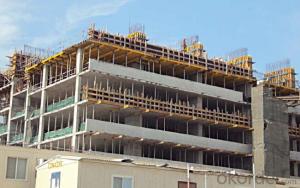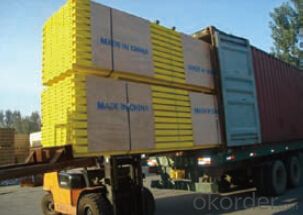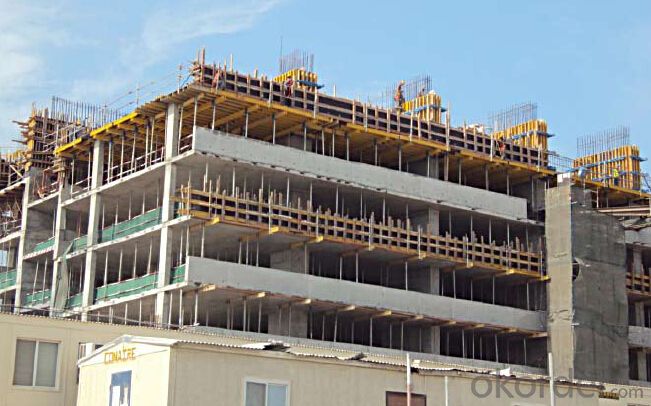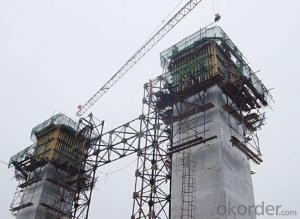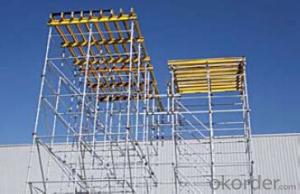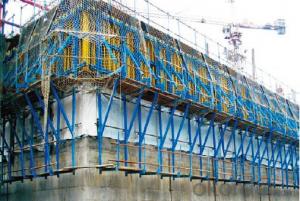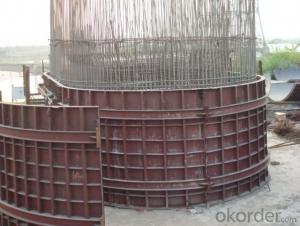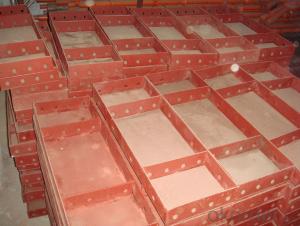Timber-Beam formwork H20 for formwork and scaffolding systems
- Loading Port:
- Tianjin
- Payment Terms:
- TT OR LC
- Min Order Qty:
- 50 m²
- Supply Capability:
- 1000 m²/month
OKorder Service Pledge
OKorder Financial Service
You Might Also Like
Characteristics:
◆ Standardized production lines.
Supply capability: 3000m/day, Lmax = 6600mm.
◆ Finger jointing of the flange and web, the strength of timber beam is highly improved.
Max. shearing force failure load:40KN
◆ Well treated to prevent from water penetration or erosion, so the service life maximally
extended.
Normally, CNBM timber beam H20 can be used for 4 to 5 years, the exact using time would
depend on maintenance & storage.
◆ Robust caps at the end of the girders protect against damages.


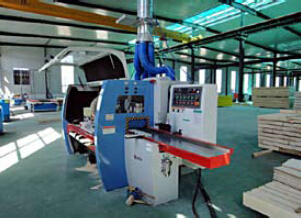
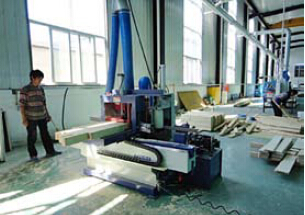
- Q: What are the standard sizes of steel formwork panels?
- The standard sizes of steel formwork panels vary depending on the manufacturer and project requirements. However, commonly used sizes include 1.2 meters by 2.4 meters (4 feet by 8 feet), 1.5 meters by 3 meters (5 feet by 10 feet), and 2.4 meters by 3.6 meters (8 feet by 12 feet).
- Q: Can steel formwork be used for complex architectural designs?
- Yes, steel formwork can be used for complex architectural designs. Steel is a durable and versatile material that can be molded and shaped into various intricate designs, making it suitable for use in complex architectural projects. Steel formwork offers several advantages such as high strength, stability, and consistency which are essential for creating complex shapes and structures. Additionally, steel formwork allows for precision and accuracy in construction, ensuring that the final design is executed exactly as intended. Overall, steel formwork is a reliable and effective choice for achieving complex architectural designs.
- Q: What are the features of the new building template?
- Now more and more domestic building template market demand, the new building template can get greater economic benefits. The new building template
- Q: How does steel formwork compare to aluminum formwork in terms of performance?
- Steel and aluminum formwork are commonly used materials in the construction industry to create temporary molds or structures that hold concrete in place until it becomes solid. When comparing these materials, it is important to consider their performance aspects. In terms of performance, steel formwork is known for its strength and durability. It can withstand heavy loads and rough handling, making it suitable for heavy-duty applications. Steel formwork also maintains its shape during the concrete pouring process, resulting in accurate finishes. It can be easily customized to meet project requirements. On the other hand, aluminum formwork is preferred for its lightweight nature. It is easy to handle, transport, and assemble, reducing labor costs and construction time. It also has excellent corrosion resistance, making it suitable for coastal areas or humid environments. Additionally, aluminum formwork provides a smooth surface finish on the concrete, requiring minimal treatment. The choice between steel and aluminum formwork depends on the specific project requirements. Steel formwork is ideal for projects with heavy loads or high reuse needs due to its strength and durability. On the other hand, aluminum formwork is a better choice for projects that require quick assembly, easy handling, and a smooth surface finish. Ultimately, the selection of formwork should be based on a careful evaluation of the project's needs, budget, timeline, and other factors such as cost, maintenance, and environmental impact.
- Q: How does steel formwork perform in earthquake-prone areas?
- Steel formwork performs well in earthquake-prone areas due to its inherent strength and durability. Steel is a highly resilient material that can withstand the forces generated during an earthquake. It has excellent tensile strength, which means it can resist bending and deformation under the seismic loads. In earthquake-prone areas, it is crucial to ensure the stability and safety of structures. Steel formwork provides a robust and reliable solution for constructing reinforced concrete structures that can withstand seismic activity. The stability and rigidity of steel formwork help in maintaining the structural integrity of the concrete elements, even during strong ground shaking. Moreover, steel formwork offers flexibility in design and construction. It can be easily adjusted or modified to accommodate changes in architectural or engineering requirements. This adaptability is particularly advantageous in earthquake-prone areas where design considerations and building codes often evolve to enhance seismic resilience. Another advantage of steel formwork in earthquake-prone areas is its reusability. Steel formwork can be dismantled and reused multiple times, making it a cost-effective and sustainable choice. This feature is essential in regions with frequent seismic activity, as it allows for efficient and economical construction practices. Furthermore, steel formwork provides better control over the quality of concrete structures. It helps in achieving precise dimensions, shape, and surface finish, which are crucial for seismic performance. The accuracy and consistency offered by steel formwork contribute to the overall structural stability and reduce the risk of structural failure during an earthquake. However, it is important to note that the performance of steel formwork in earthquake-prone areas also depends on proper engineering design, construction techniques, and adherence to building codes and regulations. The collaboration of experienced structural engineers, architects, and construction professionals is essential to ensure the effective utilization of steel formwork in earthquake-resistant construction.
- Q: Can steel formwork be used for both single-storey and multi-storey structures?
- Indeed, steel formwork is suitable for both single-storey and multi-storey structures. Its versatility and durability enable it to withstand the pressures and loads typically encountered in multi-storey construction. By providing a robust and rigid framework, steel formwork facilitates the pouring of concrete, facilitating the construction of walls, columns, beams, and slabs in both single-storey and multi-storey buildings. Furthermore, steel formwork boasts numerous advantages, including ease of use, reusability, and the ability to achieve high-quality finishes, rendering it a perfect selection for diverse structure types.
- Q: Can steel formwork be used in hygienic or sterile environments?
- When using steel formwork in hygienic or sterile environments, it is important to take precautions to maintain cleanliness and sterility. Steel formwork is a strong and durable choice for construction and is commonly used in hospitals, laboratories, and food processing facilities. However, it is important to note that steel is not naturally sterile and can harbor bacteria or contaminants if not properly maintained. To ensure the suitability of steel formwork in hygienic or sterile environments, several measures can be taken. Firstly, the formwork should be thoroughly cleaned and sanitized before use. This involves using approved cleaning agents and following specific protocols to remove dirt, debris, and potential contaminants. Furthermore, a protective coating or finish can be applied to the steel formwork to create a smooth and non-porous surface that is easier to clean and disinfect. This helps prevent the accumulation of bacteria or microorganisms on the formwork. Regular maintenance and inspections are also crucial to maintain the hygienic condition of the steel formwork. Any signs of wear, damage, or corrosion should be promptly addressed and repaired to prevent the formation of cracks or crevices where bacteria can grow. It is important to note that in extremely sensitive sterile environments, materials such as stainless steel or specialized plastics may be preferred over traditional steel formwork. These materials have properties that make them more resistant to corrosion, easier to clean, and compatible with strict hygiene or sterilization protocols. Ultimately, the suitability of steel formwork in hygienic or sterile environments depends on the specific requirements and regulations of the environment. Proper cleaning, maintenance, and adherence to hygiene protocols are essential to ensure that steel formwork can be used effectively without compromising cleanliness or sterility.
- Q: What are the different types of coatings available for steel formwork panels?
- There are several types of coatings available for steel formwork panels, each offering unique benefits and applications. 1. Galvanized Coating: This is one of the most common types of coatings used for steel formwork panels. It involves applying a layer of zinc to the surface of the steel through a process called galvanization. Galvanized coatings provide excellent corrosion resistance, making them suitable for outdoor and high-moisture environments. 2. Epoxy Coating: Epoxy coatings are known for their superior chemical and abrasion resistance. They are applied as a two-part system that combines resin and a hardener. Epoxy coatings create a strong, durable surface that can withstand heavy use and exposure to various chemicals. They are often used in industrial settings or where high performance is required. 3. Polyurethane Coating: Polyurethane coatings offer excellent resistance to abrasion, impact, and weathering. They are commonly used in applications where a high level of durability is needed, such as in construction projects or infrastructure development. Polyurethane coatings also provide good adhesion to the steel surface, ensuring long-lasting protection. 4. Powder Coating: Powder coating is a dry finishing process where a fine powder is electrostatically applied to the steel surface. It is then cured under heat to form a hard, protective layer. Powder coatings come in a wide range of colors and provide excellent resistance to chipping, scratching, and fading. They are commonly used for aesthetic purposes or in applications where a decorative finish is desired. 5. Zinc-rich Coating: Zinc-rich coatings are similar to galvanized coatings, but they contain a higher concentration of zinc particles. These coatings provide enhanced corrosion protection and are often used in highly corrosive environments, such as marine or coastal areas. Zinc-rich coatings can be applied either by spraying or brushing. 6. Fire-resistant Coating: Fire-resistant coatings are specifically designed to provide protection against the spread of fire. These coatings create a barrier that delays the heating of steel, helping to prevent the structural collapse of a building during a fire. Fire-resistant coatings are commonly used in commercial and industrial buildings, as well as in infrastructure projects. It is important to consider the specific requirements of the project and consult with experts to determine the most suitable coating for steel formwork panels. Factors such as the environment, expected durability, and budget should be taken into account to ensure optimal performance and longevity.
- Q: How does steel formwork compare to timber formwork in terms of cost?
- Steel formwork generally tends to be more expensive than timber formwork in terms of upfront costs. This is primarily due to the higher cost of steel as compared to timber. Additionally, steel formwork often requires specialized equipment and skilled labor for assembly and disassembly, which can add to the overall cost. However, it is important to consider the long-term benefits and cost-effectiveness of steel formwork. While timber formwork may have a lower initial cost, it is more susceptible to wear and tear, especially in harsh weather conditions or when used repeatedly. Steel formwork, on the other hand, is highly durable and can be used for multiple construction projects, making it a cost-effective choice in the long run. Moreover, steel formwork offers greater precision and accuracy, resulting in better quality finishes and reduced rework. It also allows for faster construction due to its ease of assembly and disassembly, which can lead to significant time and labor savings, ultimately offsetting the higher upfront cost. In summary, while steel formwork may be more expensive initially, it offers durability, reusability, and higher productivity, making it a more cost-effective option in the long term compared to timber formwork.
- Q: How does steel formwork contribute to the overall safety of the construction process?
- Steel formwork contributes to the overall safety of the construction process by providing a sturdy and stable structure for concrete pouring. Its strength and durability minimize the risk of accidents caused by collapsing or shifting formwork. Additionally, steel formwork is fire-resistant, reducing the likelihood of fire hazards on the construction site. Its reusable nature also reduces waste and potential environmental hazards, ensuring a safer working environment for construction workers.
Send your message to us
Timber-Beam formwork H20 for formwork and scaffolding systems
- Loading Port:
- Tianjin
- Payment Terms:
- TT OR LC
- Min Order Qty:
- 50 m²
- Supply Capability:
- 1000 m²/month
OKorder Service Pledge
OKorder Financial Service
Similar products
Hot products
Hot Searches
Related keywords

